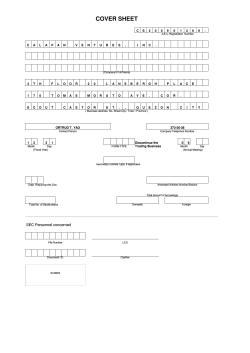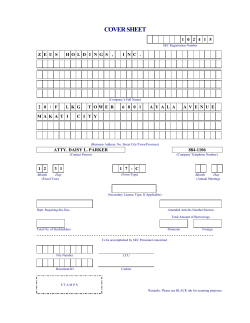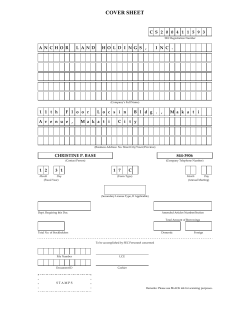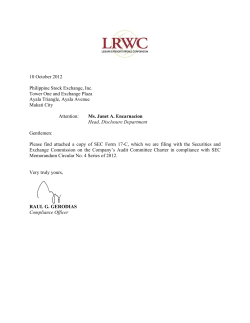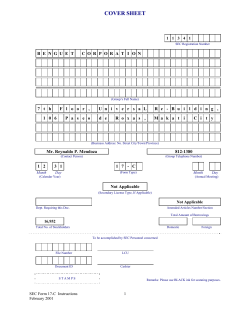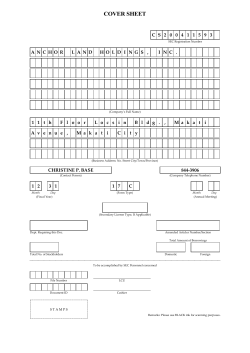
Chapter 2: Sample Questions, Problems and Solutions Örnek Sorular (Sample Questions):
Chapter 2: Sample Questions, Problems and Solutions Bölüm 2: Örnek Sorular, Problemler ve Çözümleri Örnek Sorular (Sample Questions): • • • • • • • • • • • • • • • • • • • • • • • • • • • • • • • • • • • • • • • • • • • • • • • • • • Fourier series What is a bandwidth? What is a voice-grade? Nyquist theorem Shannon theorem What is a signal-to-noise ratio? What is a magnetic media? What is a twisted pair? What is a coaxial cable? What is a fiber cable? Draw the electromagnetic spectrum and its uses for communication. What is a radio transmission? What is a microwave transmission? What is an infrared transmission? What is a lightwave transmission? What are communication satellites? What is a transponder? What is PSDN? What is an end office? What is a local loop? What is a trunk? What is a switching office? Draw a typical circuit route for a medium-distance call. What is a modem? What is attenuation? What is a distortion? What is a noise? What is an amplitude modulation? What is a frequency modulation? What is a phase modulation? What is a QPSK? What is a QAM-16? What is a full duplex channel? What is a half duplex channel? What is a simplex? What is a DSL? What is a wireless loop? What is a FDM? What is a TDM? What is a Wavelength Division Multiplexer? What is a Delta Modulation? T1, T2, T3, T4 TDM formats. What is a SONET/SDN? What is a circuit switching? What is a message switching? What is a packet switching? What is AMPS? What is D-AMPS? Draw a GSM framing structure What is a CDMA? Örnek Problemler ve Çözümleri (Sample Problems and Solutions): (Chapter 2, Problem 3-1) Television channels are 6 MHz wide. How many bits/sec can be sent if four–level digital signals are used? Assume a noiseless channel. ANS: Using the Nyquist theorem, we can sample 12 million times/sec. Four–level signals provide 2 bits per sample, for a total data rate of 24 Mbps. Maximum data rate = 2 * H * log 2 V bits/sec. = 2 * 6 MHz * log 2 4 bits/sec = 2 * 6 MHz * log 2 2 2 bits/sec = 2 * 2 * 6 MHz*bits/sec =24 Mbps (Chapter 2, Problem 3-2) Television channels are 12 MHz wide. How many bits/sec can be sent if 8–level digital signals are used? Assume a noiseless channel. ANS: Using the Nyquist theorem, we can sample 24 million times/sec. 8 level signals provide 3 bits per sample. Total data rate is 72 Mbps. (Chapter 2, Problem 5) What is signal-to-noise ratio in order to put a T1 carrier on a 150-KHz line? ANS: The data rate of T1 is 1.544 Mbps. Using Shannon theorem: H*log2(1+S/N)=1.544*106 150.000 log2(1+S/N)=1.544*106 1+S/N=210 S/N=210-1 10*log10S/N=10*log10(210-1)=10*log101023≈10*log10103≈10*3≈30 dB (Chapter 2, Problem 22) A modem constellation diagram has data points at the following coordinates: (1,1), (1,1), (-1,1), and (-1,-1). How many bps can a modem with these parameters achieve at 1200 baud? ANS: There are four legal values per baud, so the bit rate is twice the baud rate. At 1200 baud, the data rate is 2400 bps (Chapter 2, Problem 28) Five signals, each requiring 10KHz, are multiplexed on to a single channel using FDM. How much minimum bandwidth is required for the multiplexed channel? Assume that the guard is 500Hz wide. ANS: There are five 10KHz signals. We need four guard bands to avoid any interference. The minimum bandwidth required is 10000x5+500x4=50000+2000=53000Hz=53KHz. (Chapter 2, Problem 30) What is the percent overhead on a T1 carrier; that is, what percent of the 1.544 Mbps are not delivered to the end user? ANS: The end users get 7x24=168 of the 193 bits in a frame. The overhead is therefore 25/193=13%. (Chapter 2, Problem 34) A signal is transmitted digitally over a 4-kHz noiseless channel with one sample every 125 µ sec . How many bits per second are actually sent for each of these encoding methods? a) CCITT (Comite Consultatif International Telegraphique et Telegraphique) 2.048 Mbps standard. b) DPCM (Differential Pulse Code Modulation) with a 4-bit relative signal value. c) Delta modulation. ANS: a) 64 kbps b) 32 kbps c) 8 kbps (Chapter 2, Problem 53) A CDMA (Code Division Multiple Access) receiver gets the following chips: (0 0 -2 +2 0 -2 0 +2). Assuming the following chip sequences: A: (-1 -1 -1 +1 +1 -1 +1 +1) B: (-1 -1 +1 -1 +1 +1 +1 -1) C: (-1 +1 -1 +1 +1 +1 -1 -1) D: (-1 +1 -1 -1 -1 -1 +1 -1) Which stations transmitted, and which bits did each one send? ANS: A: (0 0 -2 +2 0 -2 0 +2) * (-1 -1 -1 +1 +1 -1 +1 +1)/8 =(0+0+2+2+0+2+0+2)/8=1 B: (0 0 -2 +2 0 -2 0 +2) * (-1 -1 +1 -1 +1 +1 +1 -1)/8=(0+0-2-2+0-2+0-2)/8=-1 C: (0 0 -2 +2 0 -2 0 +2) * (-1 +1 -1 +1 +1 +1 -1 -1)/8=(0+0+2+2+0-2+0-2)/8=0 D: (0 0 -2 +2 0 -2 0 +2) * (-1 +1 -1 -1 -1 -1 +1 -1)/8=(0+0+2-2+0+20-2)/8=0 A sent 1, B sent 0, C and D did not send (Chapter 2, Page 90) Can a channel of 3000-Hz bandwidth with a signal to thermal noise ratio of 30 dD transmit much more than 30 000 bps? Prove your answer. ANS: No, due to Shannon’s formula maximum number of bits/sec=H*log2(1+S/N), where 10*log10S/N=30 dB and S/N=1000 So, maximum number of bits/sec=H*log2(1+S/N)= 3000 log2(1+1000)=3000 log21001≈30000bps (Chapter 2, Problem) A tape can hold 200 Gigabytes. A box 60x60x60 cm can hold about 1000 of these tapes. What are effective bandwidth and cost if the destination is (a) an hour and (b) 24 hours away by road? ANS: Total capacity is 200 Gigabytes * 1000 = 200 Terabytes = 1600 Terabits. (a) For destination of an hour: 1600 Terabits / 3600 sec = 400 Gbps So, the effective bandwidth is over 400 Gbps. No computer network can ever approach this. (b) For destination of 24 hours: 1600 Terabits / 86 400 sec = 19 Gbps So, the effective bandwidth is over 19 Gbps. Assume that the cost of tape is $40. Assume that a tape can be reused at least ten times. So the tape cost is $4000 per box per usage. Assume that shipping is about $1000 So we have a cost of roughly $5000 to ship 200 TB. Or the cost of a Gigabyte is under 3 cents. (Chapter 2, Problem) Compute the Fourier coefficients for the function f(t) (0<=t<=1; T=1; f=1 ANS: 1 T 2 an = ∫ g (t ) sin( 2πnft )dt = 2 ∫ t sin( 2πnft )dt ⇒ Assume that 2πnt = a ⇒ T0 0 1 1 1 a da 1 1 sin( a ) a sin ada = x sin xdx = 2 2 ∫ 2πn 2πn 2π n 0 2π 2 n 2 ∫0 0 x = u ⇒ dx = du sin xdx = dv ⇒ − cos x = v 1 1 1 1 1 ( x(− cos x) − ∫ − cos xdx)dx = (− cos x * x + sin x)dx 2π 2 n 2 ∫0 2π 2 n 2 ∫0 0 2∫ = 1 − 2πn 1 t |0 = − 2 2 n πn 1 1 2π n 2 2 ∫ (− cos(2πnt ) * 2πnt + sin(2πnt ))dt = 2π 0 1 T 2 bn = ∫ g (t ) cos(2πnft )dt = 2 ∫ t cos(2πnft )dt = 0 T0 0 T c= 1 2 t2 1 ( ) = 2 = 2 |0 = 1 g t dt tdt ∫0 2 T ∫0 (Chapter 2, Problem) A noiseless 4-KHz channel is sampled every 1 msec. What is the maximum data rate? ANS: A noiseless channel can carry an arbitrary large amount of information, no matter how often it is sampled. Just send a lot of data per sample. For 4-KHz channel, make 1000 samples/sec. If each sample is 16 bits, the channel can send 16 Kbps. If each sample is 1024 bits, the channel can send 1000 samples/sec * 1024 bits = 1024 Mbps The key word here is “noiseless”. With a normal 4 KHz channel, Shannon limit would not allow this. For the 4 KHz channel we can make 8000 samples/sec. In this case if each sample is 1024 bits this channel can send 8.2 Mbps. (Chapter 2, Problem) We have a 3 KHz channel whose signal-to-noise ratio is 20 dB. A binary signal is sent by this channel. What is the maximum achievable data rate? ANS: 10 log10 S / N = 20dB S / N = 100 Using Shannon theorem, Maximum number of bits/sec = H * log 2 (1 + S / N ) = 3KHz * log 2 (1 + 100) ⇒ log 2 (101) ≠ 6,658 ⇒ = 3 * 6,658 = 19,975 Kbps Using Nyquist theorem, Maximum data rate in bits/sec = 2 * H * log 2 V = 2 * 3 * log 2 2 = 6 Kbp The bottleneck is therefore the Nyquist limit, giving a maximum channel capacity of 6 Kbps. (Chapter 2, Problem) How much bandwidth is there in 0,1 micron of spectrum at a wavelength of 1 micron? ANS: We use ∆f = c∆λ λ 2 , where ∆λ = 10 −7 meters is the width of a wavelength and λ = 10 −6 meters is a wavelength. This gives a bandwidth ∆f = 30,000 GHz. (Chapter 2, Problem) It is desired to send a sequence of computer screen images over an optical fiber. The screen is 480x640 pixels, each pixel being 24 bits. There are 60 screen images per second. How much bandwidth is needed, and how many microns of wavelength are needed for this band at 1,30 microns? ANS: The data rate is 480x640x24x60 bps=442 Mbps. For simplicity, let us assume 1 bps per c∆λ ∆fλ2 Hz. From ∆f = 2 we find ∆λ = λ c 8 We have ∆f = 4,42 x10 , so ∆λ = 2,5 x10 −6 microns. As we see the range of wavelengths used is very short. (Chapter 2, Problem) Compare the maximum data rate of a noiseless 4 KHz channel using a) Analog encoding (e.g. QPSK) with 2 bits per sample. b) The T1 PCM system. ANS: a) In both cases 8000 samples/sec are possible. With QPSK encoding, two bits are sent per sample. So the maximum data rate for QPSK is 16 Kbps. b) With T1, 7 bits are sent per period. So the maximum data rate for T1 is 56 Kbps.
© Copyright 2025




